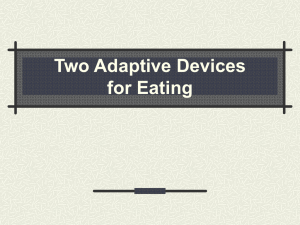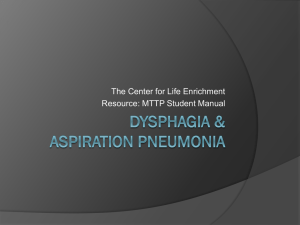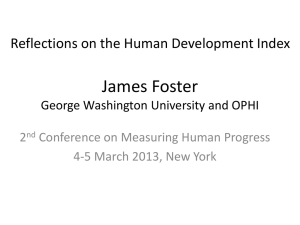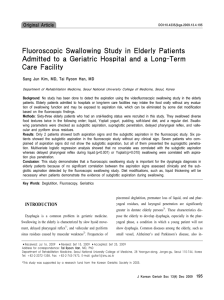Presentation by Jo Patterson
advertisement
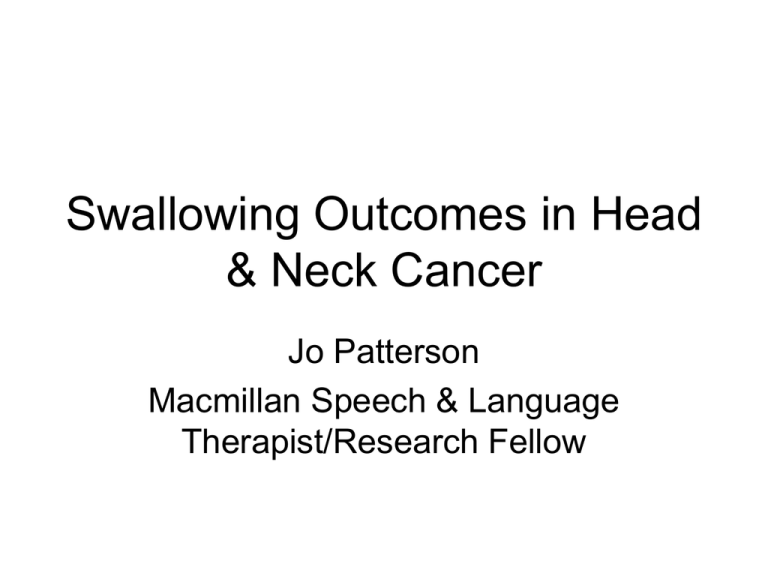
Swallowing Outcomes in Head & Neck Cancer Jo Patterson Macmillan Speech & Language Therapist/Research Fellow Swallowing Outcomes • Critique assessments • Collector’s perspective • Patient rated outcomes • Clinical scales • Clinical indicators Patient reported outcomes • SWAL-QOL / SWAL-CARE • M.D.Anderson Dysphagia Inventory SWAL-QOL (McHorney 2002) • Devised from patient focus group (N=549, 14.5% head & neck cancer) • Good correlation with UWQOL (Lovell 2005) • Moderately related to pathophysiology Measurement tool • SWAL-QOL 2002 (44 items, 11 domains) general burden* food selection* eating duration eating desire fear of eating mental health* social function* symptom frequency (fatigue) (sleep) (communication) Data Sample • • • • • N=65 (49 males; 16 females) Age 32-80y mean 60y Oral (31) oropharyngeal (30) NPC (4) T1-2 (35) T3-4 (30) Surgery (10) surgery & radiotherapy (36) chemoradiotherapy (13) radiotherapy (6) • 35 completed pre & post SWAL-QOL • Analysed using ANOVA COUGH - FOOD STUCK DRIBBLE FROM NOSE Site DRIBBLE FROM MOUTH Worst QoL FOOD STICKMOUTH * FOOD STICK THROAT Gender PROBLEM CHEWING DROOLING CLEAR THROAT EXCESS SALIVA, PHLEGM GAGGING THICK SALIVA, PHLEGM CHOKE ON LIQUID CHOKE ON FOOD * COUGHING SOCIAL FX MENTAL HEALTH FEAR OF EATING EATING DESIRE T stage EATING DURATION FOOD SELECTION GENERAL BURDEN Pre-treatment Best QoL * * Female Male * 1 or 2 3 or 4 * Oral Oropharyngeal Nasopharyngeal COUGH - FOOD STUCK DRIBBLE FROM NOSE DRIBBLE FROM MOUTH Worst QoL FOOD STICKMOUTH Treatment FOOD STICK THROAT Site PROBLEM CHEWING DROOLING CLEAR THROAT EXCESS SALIVA, PHLEGM GAGGING THICK SALIVA, PHLEGM Gender CHOKE ON LIQUID CHOKE ON FOOD COUGHING SOCIAL FX MENTAL HEALTH FEAR OF EATING EATING DESIRE EATING DURATION FOOD SELECTION GENERAL BURDEN 6 months post treatment Best QoL * Female Male T stage 1 or 2 3 or 4 * Oral Oropharyngeal Nasopharyngeal * Surgery Surgery & Radiotherapy Chemoradiotherapy Radiotherapy Collector’s perspective • Author’s report 14 mins to complete – much longer needed • Difficult to analyse – many components • Good sections – includes symptoms • Not to be done cross-sectional M.D. Anderson Dysphagia Inventory (Chen 2001) • 20 items (sub-groups emotion, physical, function) • Devised from professionals (SALTs & Surgeons) • Good reliability • Correlates with UWQOL • No association with aspiration (Gillespie 2005) • Used as outcome for swallowing exercises (Kulbersh 2006) MDADI pre & post CRT Demographics T1 T2 T3 T4 Tx Orophx 6 9 7 24 - Hypophx 2 3 6 6 - Larynx 23 6 11 4 - U/k 1° - - - - 9 Total = 116 Comparison pre & post Collector’s perspective • 10 mins to complete • ‘no opinion’ poses difficulties • Difficult to use on someone without swallowing difficulties • Difficult to use on NBM patients • One item complex double negative Quality of Life Questionnaires • University of Washington QOL Scales • DAHNO • Correlates with VFSS, HADS, MDADI, SWALQOL, TOMS • Short, quick to complete • Wide research base • Difficult to find out how it was devised • Reproducible, reliable & valid • Originally intended for surgical group • Additions of taste, saliva, mood, anxiety • Speech & saliva difficult for people to answer Pre-treatment priorities University of Washington QOL pre-treatment 45 40 35 % 30 25 20 15 10 5 0 h y w iet ec llo x e a an sp sw in pa m d oo a liv a s n wi e ch g i tiv c a Domain ty er ce on i d n t l a a ou ar re h e c s p re ap ste ta Clinical Scales • Performance Status Scales (List ’90) • Therapy Outcome Measures (TOMS) • FIGS Performance Status Scales (List 1990) • Developed by surgeons, oncologists & SALTs • Purpose; research & clinical • Normalcy of diet, eating in public, communication • Rated by ‘health professionals’ • High reliability • Correlates with QOL • Included in DAHNO dataset Diet scale pre vs. 3 months post Chemoradiotherapy Performance Status Scale pre to 3 month difference 100 90 Score difference 80 70 60 50 40 30 20 10 0 NPC Unknown Orophx Site Hypophx Larynx Collectors perspective • • • • • • • Quick Can be done by other staff Some diets difficult to grade Can give false positive results Gradations ?equal Large literature base for comparison ?swallowing outcome Therapy Outcome Measures (Enderby ’77) 10 core patients specific scales • ‘Laryngectomy’ only scale specific to H&NC • Scales on voice, dysarthria, phonology & dysphagia • Pilot study Radford et al 2003 – Correlates with UWQOL scales – ?modification for H&NC Functional Intraoral Glasgow Scale (FIGS)(Goldie 2006) • Originated Canniesburn Hospital • 3 scales – chew, swallow & speech • Total score of all 3 items Clinical Indicators • • • • Aspiration / penetration Residue Swallowing efficiency Feeding tube dependency Aspiration / Penetration • H&NC literature focuses on aspiration • Penetration / aspiration scale (Rosenbek) – Increases reliability of findings – One score – Requires instrumental assessment – ?meaningful to clinical picture / patient % Aspiration Post CRT 100 90 % aspiration 80 70 60 50 40 30 20 10 0 Nguyen Kotz Smith Pauloski Graner Eisbruch Chang % Aspiration pneumonia Aspiration Pneumonia 100 90 80 % pneumonia 70 60 50 40 30 20 10 0 Kendall Nguyen Chang Studies Wu Eisbruch Swallowing Efficiency • Residue • Oropharyngeal swallowing efficiency • Water swallow test Mean time to swallow 100mLs water pre-treatment 18 16 14 12 10 8 6 4 2 0 Un kn ow n La ry nx Mean Site 16 14 12 Mean time yn x Mean time O ro ph ar Hy po ph ar yn x Time Mean time 10 8 6 Mean 4 2 0 T1 T2 T3 Tumour stage T4 Tx Tube feeding NPC T.Base U/k 1° Total No Peg 4 12 11 27(40%) 0-4week - 5 - 5(12%) 4-12wks 1 1 1 3(7%) 12-24wks 1 7 1 9(22%) 24-52wks 4 11 2 17(14%) >52wks - 6 1 7(17%) 10 42 16 68 Total DAHNO • Was the patient seen for pre treatment SALT assessment? • PSS Normalcy of Diet • Weight • Type & timing of nutritional support Summary • • • • • • • • Choice of measures One-dimensional, cross-sectional misleading Needs to be longitudinal, set time points Simple / collectable What questions to ask of the data It will require dedicated time ?interventions DAHNO

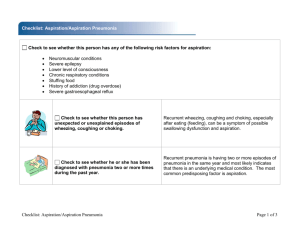
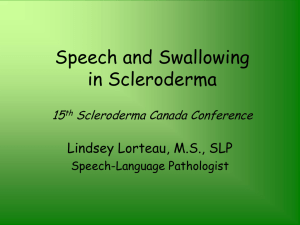



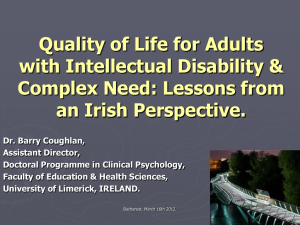
![Dysphagia Webinar, May, 2013[2]](http://s2.studylib.net/store/data/005382560_1-ff5244e89815170fde8b3f907df8b381-300x300.png)
